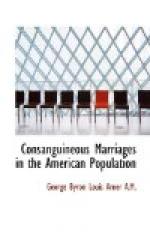Professor Ward’s idea of “difference of potential,” or contrast, as essential to the highest vigor of the race as well as to that of the individual offspring, offers an alternative explanation of the observed results of consanguineous marriages, and one which does not necessarily conflict with the explanation already given. All the phenomena of intensification are simply due to a resemblance between husband and wife in particular characteristics, such as a common tendency toward deafness or toward mental weakness. This resemblance, which may or may not be the result of a common descent, renders more probable the appearance of the trait in the offspring. If the parents closely resembled each other in many respects they would be more likely to “breed true” and the children would resemble one another in their inherited traits, thus accounting for the high average of deaf-mutes to the family, observed in the Irish statistics.[99]
[Footnote 99: Cf. supra, p. 66.]
The theory of contrast and resemblance supplements that of intensified heredity where the resemblance is general, rather than in particular traits or characteristics. In such a case the absence of the stimulating effects of contrast might result in a lowering of vitality, which in turn would react upon the youthful death-rate.
Where then related persons differ greatly in mental and physical traits, and generally speaking, belong to different types, it is very improbable that there would be any ill effects resulting from the mere fact of consanguinity. A case in point is furnished me by a correspondent. A first cousin marriage which turned out exceedingly well was between strongly contrasted individuals; the husband was “short, stocky and dark complexioned” while the wife was “tall, slight of figure, and of exceedingly light complexion.” In other cases in which the results were not so good the husband and wife bore a close resemblance to one another, physically and mentally.
This, however, does not agree with the results obtained by Professor Karl Pearson. Basing his conclusions on the correlation of stature between husband and wife, he believes that homogamy is a factor of fertility. Taking 205 marriages from Mr. Francis Galton’s Family Records, Professor Pearson found the correlation between husband and wife to be .0931 +- .0467, while weighted by their fertility the correlation was .1783 +- .0210, practically doubling the intensity of assortative mating.[100] The value of these correlations, however, is impaired, as he says, by the insufficient number of observations, and by the fact that absolutely taller mothers are the more fertile.
[Footnote 100: Royal Society Proceedings, vol. 66, p. 30.]
In a subsequent investigation of from 1000 to 1050 pairs of parents of adult children, Professor Pearson found the correlation in stature to be .2804 +- .0189; of span .1989 +- .0204; and of forearm .1977 +- .0205; with cross coefficients varying from .1403 to .2023. If, as he believes, “The parents of adult children are on the average more alike than first cousins, then it follows that any evils which may flow from first cousin marriage depend not on likeness of characters, but on sameness of stock."[101]




